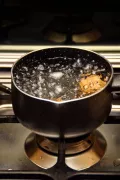Poached eggs are a breakfast favorite for many, but they can be intimidating to make at home. If you've ever struggled to achieve that perfect poached egg with a runny yolk and firm white, you're not alone. In this guide, we'll break down the science behind poaching eggs, provide a step-by-step guide, and offer tips and tricks for perfect results every time. Whether you're a seasoned cook or a beginner, you'll be able to poach eggs like a pro in no time.
The Science Behind Poaching Eggs
Before we get into the specifics of how to poach eggs, it's important to understand the science behind the cooking process. When an egg is poached, the heat of the water coagulates the egg white and yolk proteins, causing them to solidify. The key to a perfect poached egg is achieving a delicate balance between solidification and runniness.
To achieve this balance, there are a few important factors to consider. Firstly, the freshness of the egg is crucial. The fresher the egg, the tighter the proteins will be, which means that the egg will hold its shape better during cooking.
The second factor is the temperature of the water. Water that is too hot will cause the proteins in the egg to coagulate too quickly, resulting in a tough, rubbery egg. On the other hand, water that is too cold will not cook the egg enough. The ideal temperature for poaching eggs is between 160-180°F (71-82°C).
Another important factor is the addition of salt and vinegar to the water. While some recipes call for the addition of these ingredients, others do not. Salt can help to flavor the egg, while vinegar can help to coagulate the proteins more quickly, resulting in a firmer, more compact egg white.
Equipment Needed for Poaching Eggs
While you don't need any specialized equipment to poach eggs, having the right tools can make the process easier and more efficient. Here are the essential tools you'll need to poach eggs:
- A saucepan: Choose a saucepan that is large enough to hold the number of eggs you want to poach without overcrowding.
- A slotted spoon: A slotted spoon will allow you to gently remove the eggs from the water without damaging them.
- An egg timer: A timer will help you keep track of the cooking time and ensure that the eggs are cooked to your desired level of doneness.
If you prefer, you can also use specialized equipment such as silicone egg poaching cups or a dedicated poaching pan. These tools can help to shape the eggs and ensure that they cook evenly.
How to Poach Eggs: Step-by-Step Guide
Now that you understand the science behind poaching eggs and have the right equipment, it's time to get into the nitty-gritty of how to poach eggs. Here is a step-by-step guide to follow:
- Fill a large saucepan with water and bring it to a gentle simmer over medium-high heat. Add salt and vinegar to the water, if desired.
- Crack an egg into a small bowl or ramekin. This will help you to easily slide the egg into the water without breaking the yolk.
- Use a slotted spoon to create a whirlpool in the water. This will help the egg white to wrap around the yolk and create a more cohesive shape.
- Gently slide the egg into the water and use the slotted spoon to ensure that the egg stays together.
- Cook the egg for 2-4 minutes, depending on your desired level of doneness. Use an egg timer to ensure that you don't overcook the egg.
- Use the slotted spoon to remove the egg from the water and place it on a plate lined with paper towels to absorb any excess water.
- It's important to note that the cooking time may vary depending on the size of the egg and the temperature of the water. It may take some trial and error to find the perfect cooking time for your desired level of doneness.
Tips and Tricks for Perfect Results Every Time
While the basic process of poaching eggs is relatively straightforward, there are a few tips and tricks that can help you to achieve perfect results every time. Here are a few to keep in mind:
- Use fresh eggs: Fresh eggs have tighter proteins, which means that they will hold their shape better during cooking. If possible, choose eggs that are less than a week old.
- Bring the water to a gentle simmer: A rolling boil will cause the eggs to break apart, so it's important to bring the water to a gentle simmer before adding the eggs.
- Add vinegar to the water: Adding a splash of vinegar to the water can help the egg white to coagulate more quickly, resulting in a more compact egg.
- Use a slotted spoon to remove excess water: Once the egg is cooked, use a slotted spoon to remove it from the water and gently shake off any excess water.
- Season the egg: Poached eggs are delicious on their own, but they can also be seasoned with salt, pepper, or other herbs and spices. Try adding a sprinkle of smoked paprika or chopped chives for extra flavor.
Troubleshooting Poached Eggs
Even with the best tips and tricks, it's possible that your poached eggs won't turn out perfectly every time. Here are some common problems that may arise and how to fix them:
- The egg is not fresh enough. Try reducing the temperature of the water and using a fresher egg.
- The yolk is not runny: If the yolk is not runny, it may be because the egg was overcooked. Try reducing the cooking time and monitoring the egg closely.
- The white is too rubbery: If the white is too rubbery, it may be because the water is too hot or the egg is not fresh enough. Try reducing the temperature of the water and using a fresher egg.
Conclusion
Poaching eggs may seem intimidating, but with a little practice and the right techniques, anyone can achieve perfect results every time. Remember to choose fresh eggs, bring the water to a gentle simmer, and use a slotted spoon to remove excess water. With these tips and tricks, you'll be able to enjoy delicious, runny-yolked poached eggs at home in no time.






